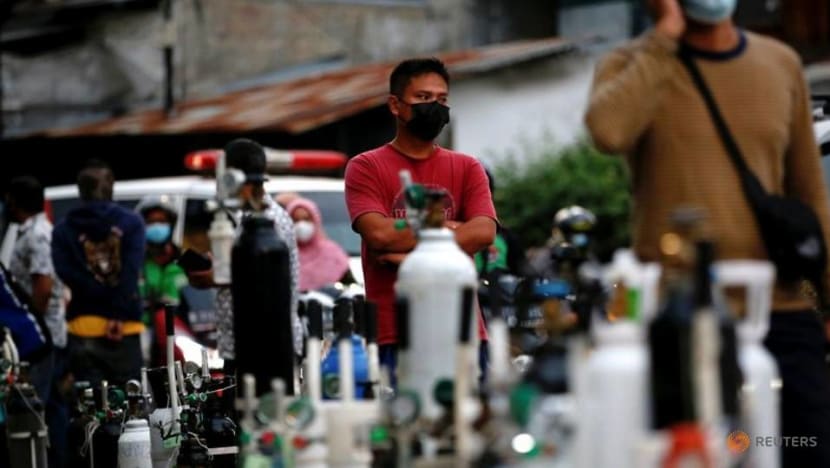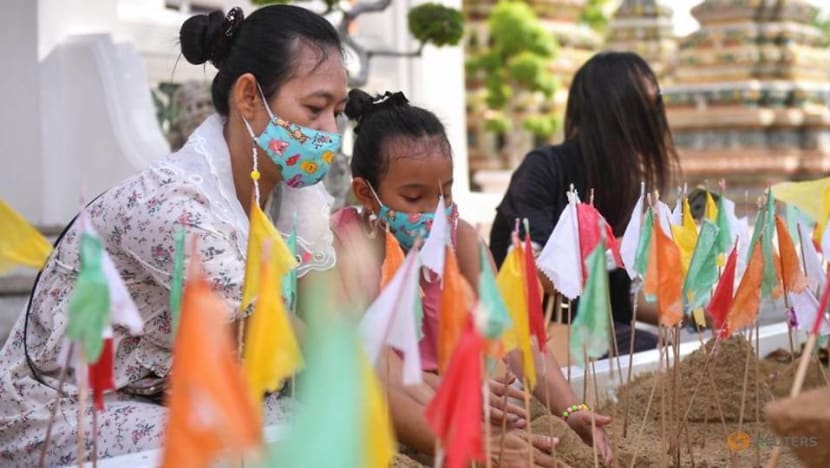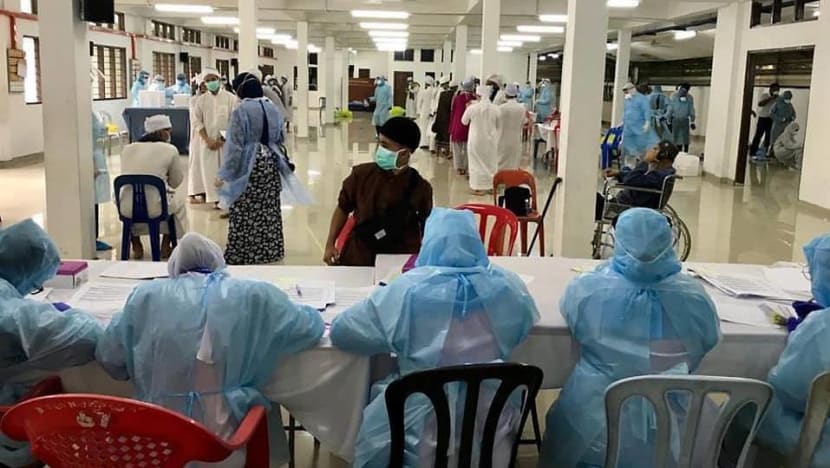Commentary: Southeast Asia is buckling under a second year of COVID-19
COVID-19 is a sustained test of state capacity, and Southeast Asian countries are faring poorly, says a doctor.

FILE PHOTO: A man wearing a protective mask queues to refill oxygen tanks as Indonesia experiences an oxygen supply shortage amid a surge of coronavirus disease (COVID-19) cases, at a filling station in Jakarta, Indonesia, July 5, 2021. REUTERS/Willy Kurniawan
KUALA LUMPUR: The second year of the COVID-19 pandemic has not been kind to Southeast Asian countries. The region is experiencing accelerated national-level tragedies played out in accelerated speed.
Few have any semblance of control. Brunei has had no community transmission since May 2020. Singapore has done comparatively more tests (2.2 tests per capita to Indonesia’s mere 0.04 per capita). And Vietnam has the region’s lowest mortality rate (0.71 per million – impressive given its population of 96 million).
Thailand had only 6,884 cases in 2020 but has seen 220,000 so far this year. Malaysia recorded 113,000 cases in 2020 but has had 592,000 cases since the beginning of the year – a number that is likely higher due to under-testing. Runaway infections in Indonesia have caused approximately 33,000 deaths over the first half of 2021.
This pandemic is a sustained test of state capacity, with many potential political or policy pitfalls. But there are many explanations for the diverging fates within Southeast Asia.
READ: Commentary: Malaysia king’s role comes into sharper focus as country sails through bleakest COVID-19 days
READ: Commentary: A different Malaysia may emerge from the ashes of its COVID-19 crisis
FACTORS FOR SUCCESSFUL COVID-19 MANAGEMENT
Countries that perform more tests (Singapore and Vietnam) appear to do better than those that do not (Indonesia or the Philippines).
Countries with strong central governments (Brunei, Singapore and Vietnam) also appear better able to marshal the whole-of-government and all-of-society approaches that are needed.
Although mass movements were cancelled in both 2020 and 2021, Indonesians still found ways around the ban and travelled to their hometowns for Eid Al-Fitr celebrations in May 2021. Thais still celebrated Songkran in April.
Both Indonesia and Thailand saw spikes approximately two weeks after. Pandemic fatigue and missing out on the biggest cultural holidays two years in a row was unacceptable for too many citizens.

Slow vaccination rates also seem to be contributing but are only part of the explanation. Slow vaccinations aren’t causing worse outcomes in Vietnam – which has by far the lowest number of cases per capita in Southeast Asia, despite only 2.4 per cent of Vietnamese receiving a vaccine.
This compares to 5.7 per cent in the Philippines, 7.9 per cent in Thailand and 8.4 per cent in Indonesia.
COVID-19 mutations are another potential explanation for the deterioration in 2021. Vietnam’s health minister has connected their recent surge to new, more infectious variants.
Yet the scale of the threat to Southeast Asia is difficult to quantify because the region does not have adequate genomic surveillance.
It is possible that the large waves of infections in 2021 are still due to the original version of SARS-CoV-2, given all Southeast Asian countries have strict restrictions on inbound international travel.
READ: Commentary: Thailand’s Phuket sandbox can peel open travel despite limitations
READ: Commentary: Can Phuket's sandbox be a model for vaccine tourism?
TURNING THE TIDE
Can Southeast Asia turn the tide in the second half of the year?
Strategies need to be better designed and involve solutions which should have already been familiar and logical – behavioural changes (masks and physical distancing), testing, tracing and isolation, and targeted short-term movement restrictions (instead of blunt prolonged national lockdowns).
Policy implementation must be evidence-based, well-financed and free from excessive red tape. Policies should integrate with private healthcare, as it forms 53 per cent of the sector in Southeast Asia.
Countries also need to vaccinate as fast as possible. Countries can build pop-up vaccination centres (as has been done in mosques in rural Indonesia), fight vaccine hesitancy (such as restaurant discounts and lucky draws seen in the Philippines), partner with the private sector (as Malaysia or Singapore have done), develop their own vaccines (as in Vietnam and Thailand), and offer free last-mile transport to vaccination centres.
Countries should also prepare the health, legal, regulatory and political infrastructure for matters surrounding vaccination, such as vaccine passports and antibody tests.

Southeast Asian countries need to better collaborate and look beyond their own borders for solutions. A pooled vaccine procurement system could help and could be modelled off the Pan American Health Organization’s Revolving Fund.
Pooled procurement can reduce costs, improve equity and increase negotiating power with pharmaceuticals. Feeding into great power engagement in Southeast Asia, the involvement of the United States and China could be requested in the financing, technical and political set-up of such a fund.
READ: Commentary: A pity China can’t seem to ditch its wolf warrior diplomacy
Southeast Asia could also more actively participate in the global discourse on vaccine equity and global health governance reform.
Countries in the region could get more involved in the global effort to secure patent waivers and technology transfers for COVID-19-related medical goods. This would allow Indonesian, Malaysian and Singaporean factories to produce vaccines for regional use.
Badly hit Southeast Asian countries can recover in the second half of 2021 by better absorbing lessons from 2020 and other countries. Recovery will depend on understanding the science, exercising good judgment and through opposing hubris, petty politics and complacency.
BOOKMARK THIS: Our comprehensive coverage of the COVID-19 pandemic and its developments
Download our app or subscribe to our Telegram channel for the latest updates on the coronavirus outbreak: https://cna.asia/telegram
Dr Swee Kheng Khor is an independent health policies specialist based in Kuala Lumpur, Malaysia. This commentary first appeared on East Asia Forum.












